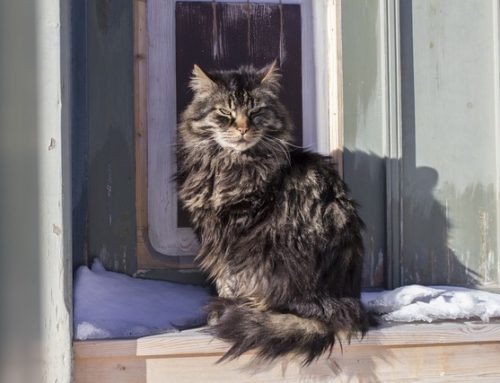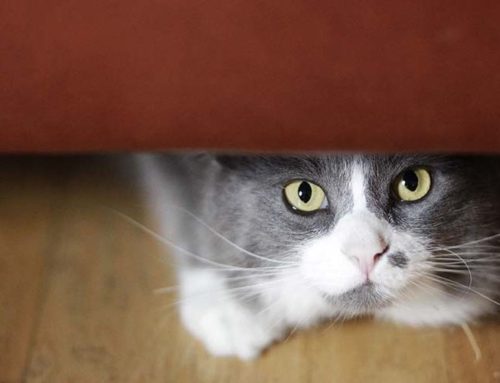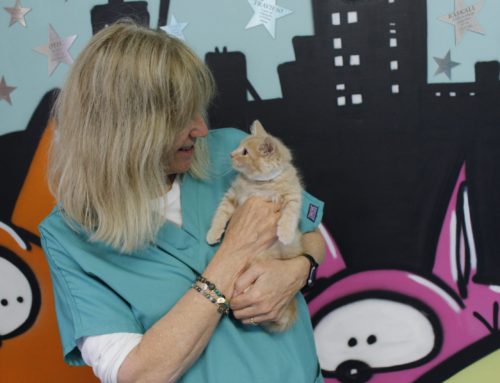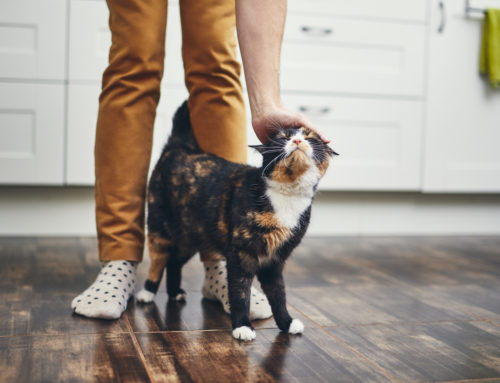 What’s in a name, right? In this case not much. Ringworm has nothing to do with worms. Nor does it always show up as a ring!
What’s in a name, right? In this case not much. Ringworm has nothing to do with worms. Nor does it always show up as a ring!
Ringworm is a skin infection caused by a fungus, otherwise known as dermatophytes. These are microscopic parasitic fungi that live on the skin, specifically in hair follicles. Ringworm is a very hardy fungus that can be present in soil. Cats and cattle are the two species of animals that seem to get ringworm the most, although dogs and other animals can contract it. Humans can also get ringworm, either from a pet or from their environment. Athlete’s foot and jock itch are two types of ringworm that humans can get, sometimes from public places like locker rooms or public swimming pools.
Cats can contract ringworm when they are exposed to infected soil, when they come in direct contact with another infected animal or person, or indirectly through their living environment. Because the spores are microscopic and contagious, ringworm can be passed between cats via shared bedding, shared grooming tools, cat carriers, furniture, carpeting, etc. It’s also hard to get rid of; ringworm spores can be persistent in the environment for up to two years.
Those most susceptible to ringworm are kittens and cats less than one year old, who are still developing an immune system, or cats whose immune systems are suppressed, such as FIV+ cats. Longhaired cats are also more prone to ringworm than are shorthaired cats. Senior cats, stressed cats (maybe due to a recent move, a new cat in the household, or a recent adoption) and free-roaming cats that are outside and exposed to soil are all more susceptible to contracting ringworm.
Ringworm generally first shows itself as a small lesion with scaly skin in the center, which then grows to be a ring of patchy hair loss. Ringworm lesions and patches of hair loss are frequently localized to the cat’s face, ears, and limbs, but they can occur anywhere on the body. The patches don’t always occur in a circle, either; sometimes ringworm shows up just as patchy baldness, and it can be with or without redness and/or inflammation. There is usually mild itching associated with ringworm, and cats will often show an early sign of ringworm by scratching at their ears. Hair-loss patches can come and go during the infection cycle. Just because the patch is going away doesn’t mean the cat is cleared of the infection.
Ringworm is definitely contagious — both to other pets and to humans. That said, it’s important to know that ringworm on cats will generally self-resolve within two to four months — meaning, it typically goes away on its own if you do nothing at all. For feral cats, ringworm is generally not treated and it normally self-resolves. For tame cats, there are things you can do to speed up the healing process, as well as decrease the chances of reoccurrence.
Diagnosing Ringworm
 Vets will normally first check for ringworm by using what’s called a “woods lamp.” Under the lamp in a dark room, the ringworm fungus fluoresces apple green. Normally the whole hair shaft will glow, especially the base. A woods lamp is not complete indicator, though, because only about 60% of ringworm fungi show up under a woods lamp. To make things more complicated, doxycycline, terramycin, carpet fibers and dust can also cause the hair shaft to glow.
Vets will normally first check for ringworm by using what’s called a “woods lamp.” Under the lamp in a dark room, the ringworm fungus fluoresces apple green. Normally the whole hair shaft will glow, especially the base. A woods lamp is not complete indicator, though, because only about 60% of ringworm fungi show up under a woods lamp. To make things more complicated, doxycycline, terramycin, carpet fibers and dust can also cause the hair shaft to glow.
The most accurate diagnosis is by a vet taking a sample skin scraping from your cat, usually with a toothbrush, and then growing the culture in a lab. The culture can take 10-21 days to grow. This is a routine culture that your vet can perform, and it’s really the most accurate diagnosis.
Treating Ringworm
Vets will generally prescribe some combination of the below treatments for ringworm, to speed up the healing process:
- Clipping the hair – This is important to reduce the spread and so that the treatment can reach the skin, especially for cats with longer hair. Clipping should only be done by your vet, because you need extreme care to avoid further traumatizing the skin or further spreading the infection. Clippers should be sterilized and hair disposed of carefully.
- Lime-sulphur dips or enilconazole (Clinafarm EC) – This is the most often prescribed treatment. The infected cat is bathed with the lime-sulphur solution twice a week for 2-4 weeks. The lime-sulphur dip smells bad and there may be some slight discoloration of the cat’s coat, turning it yellowish, but that will go away on its own. Don’t rinse it off, and don’t let your cat lick the coat while it’s still wet from the dip.
- Antifungal liquids containing itraconazole – Similar to lime-sulphur dips, this solution is sponged on or applied to the cat’s coat, every other week for six weeks (three treatments in total). It is safe to use in kittens from 10 days and up, but use extreme caution if treating pregnant queens.
- Topical anti-fungal creams (i.e. miconazole or thiabendazole) – Anti-fungal creams are applied topically once or twice a day for 2-4 weeks. Antifungal creams are typically recommended for use on both people and pets with ringworm and are very effective. They also help reduce any itching and redness.
- Oral anti-fungal medication – your vet may prescribe oral anti-fungal agents if the lesions are severe or if the nail beds are infected. Sometimes these oral medications have serious side effects, so you should discuss with your vet what the possible side effects are before beginning treatment.
As you are treating a cat for ringworm, you will want to take the cat back in to your vet every 2-4 weeks to take a new culture. The cat is not considered fully cleared of the infection until you get two clean (negative) cultures two weeks apart. Also, because the ringworm taxes the cat’s overall system, you will want to make sure your cat is on high quality diet, specifically feeding good quality wet food. Good quality wet food will strengthen their immune system, so the body is getting the nutrients it needs and is supported during the healing process.
Also, if you or someone in your household has HIV or is undergoing chemotherapy, these individuals are more at risk of contracting ringworm from a pet.
Preventing the Spread of Ringworm
Single-cat households
Even if there are no other cats in the household, you still may want to consider restricting your infected cat to just one room in your house to make cleaning easier. Do not allow the cat to go outdoors.
Multi-cat households
Whenever you take a new cat into a multi-cat household, it’s good practice to isolate new cats for 14-21 days before co-mingling them because any contagious diseases or infections generally show up within that timeframe. If you were able to successfully isolate the cat prior to the spread of the ringworm infection, you will want to use extreme caution between handling the infected cat and caring for your regular crew. Be very careful to wash your hands, use gloves and change your clothes after handling the infected cat.
If you have a multi-cat household and you have taken a ringworm-infected cat into your house, you should consider having all cats checked by your vet. Because the spores are microscopic, there is a strong likelihood that the other cats in your household will still contract ringworm. However, also know that it might not affect all of your cats. Remember, it affects kittens and cats under one year, seniors, longhairs and cats with compromised immune systems the most. A healthy, adult cat might not be affected. Generally, the more cats involved, the longer the treatment time and the longer/more difficult it is to decontaminate the environment.
If you were able to successful isolate the cat prior to the spread of the ringworm infection, only co-mingle cats again after the ringworm-infected cat tests negative on two consecutive cultures, each two weeks apart. If you weren’t able to isolate the cat prior to the spread, you may need or want to consider treating all of the cats in your household.
Cleaning the household
Vacuum daily and thoroughly. Ringworm spores are very light so vacuuming is actually very effective; a vacuum can suck up the spores easily. Vacuum all surfaces, furniture, drapes and carpets and follow with a damp mop where possible. Empty the vacuum bag or canister frequently, and if it’s a canister, bleach it out using a bleach-water solution (1:10 – one part bleach to 10 parts water). Use a bleach-water solution to disinfect all hard surfaces and try to leave the bleach on for about 10 minutes to kill all fungi. Also use bleach in the laundry for pet bedding, towels, etc. It’s a good idea to have your heating and cooling ducts professionally vacuumed out, too. Make sure you use a bleach-water solution to cleaning your grooming tools, cat carriers, litter pans, traps, taming cages, collars, toys, baskets, etc.
If you are a rescuer, be very cautious about using other people’s grooming tools at adoption events or sharing cat carriers unless they are thoroughly bleached. Also at adoption events, you always want to disinfect your hands in between handling different cats, and make sure that potential adopters disinfect their hands before petting or handling cats, too.
Sources:
“Ringworm (Tinea): Fungal Skin Infection.” Merckmanuals.com. 2009. April 10, 2011 <http://www.merckmanuals.com/home/sec18/ch212/ch212c.html>.
“Ringworm in Cats.” PetEducation.com. 1997-2011. April 10, 2011 <http://www.peteducation.com/article.cfm?c=21&aid=223>.
Newbury, Dr. Sandra, DVM. “Dermatophyte Treatment in a Nutshell.” Sheltermedicine.com. 2006. April 10, 2011 <http://www.sheltermedicine.com/education/lecture-library/ringworm>.







